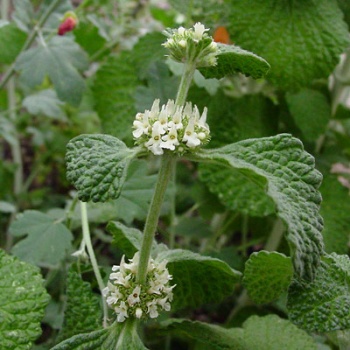Difference between revisions of "Horehound"
(→References) |
(→References) |
||
| Line 18: | Line 18: | ||
* ''N. Mnonopi; R.-A. Levendal; N. Mzilikazi; C. L. Frost (2012). "Marrubiin, a constituent of Leonotis leonurus, alleviates diabetic symptoms". Phytomedicine. 19 (6): 488–493. doi:10.1016/j.phymed.2011.12.008. PMID 22326550.'' | * ''N. Mnonopi; R.-A. Levendal; N. Mzilikazi; C. L. Frost (2012). "Marrubiin, a constituent of Leonotis leonurus, alleviates diabetic symptoms". Phytomedicine. 19 (6): 488–493. doi:10.1016/j.phymed.2011.12.008. PMID 22326550.'' | ||
*''Anti-proliferative effect of horehound leaf and wild cherry bark extracts on human colorectal cancer cells. | *''Anti-proliferative effect of horehound leaf and wild cherry bark extracts on human colorectal cancer cells. | ||
| − | Yamaguchi K1, Liggett JL, Kim NC, Baek SJ. | + | Yamaguchi K1, Liggett JL, Kim NC, Baek SJ. PMID 16328068'' |
[[Category:Treatments]] | [[Category:Treatments]] | ||
[[Category:herbal medicine]] | [[Category:herbal medicine]] | ||
Revision as of 02:06, 29 January 2017
Other Names : Marrubium vulgare, hoarhound, white horehound, Malrove, Gewöhnlicher Andorn, Marrube blanc. A different genus, the black horehound (Ballota nigra), is a fetid-odored perennial native to the Mediterranean area that sometimes is used as an adulterant of white horehound.
Horehound is native to Europe and Asia and has been naturalized to other areas, including the US. It is a perennial, aromatic herb of the mint family. The plant has oval leaves covered with white, woolly hairs, and bears small, white flowers.
See also : Bitters
Special Precautions of Horehound
Large doses may induce cardiac irregularities.
Health Benefits and uses of Horehound are
Horehound has been used as a vasodilator, diaphoretic, diuretic, and treatment for intestinal parasites. Initial animal studies indicate that horehound may have hypoglycemic effects and may influence bile secretion. The volatile oil of horehound has been reported to have expectorant and vasodilatory effects. Evidence is limited on these medicinal uses.
- The leaves and flower tops of the horehound have long been used in home remedies as a bitter tonic for the common cold. Horehound has been used traditionally as an expectorant and continues to find a place in cough lozenges and cold preparations.
- It now is used primarily as flavorings in liqueurs, candies and cough drops.
- In addition, extracts of the plant were used for the treatment of intestinal parasites and as a diaphoretic and diuretic.
- The essential oil of M. vulgare contains potent antimicrobial and anticancer properties
- Colon cancer : In the investigation of Marubium vulgare (horehound) and Prunus serotina (wild cherry) extracts and theirs anti-inflammatory and exhibition of anti-proliferative activity in human colorectal cancer cells found that Both horehound and wild cherry extracts cause suppression of cell growth as well as induction of apoptosis.
- one of the primary active compounds : Marrubiin, found in horehound, possesses "antidiabetic, anti-atherogenic and anti-inflammatory properties.
References
- Horehound. Review of Natural Products. factsandcomparisons4.0. 2005. Available from Wolters Kluwer Health, Inc. Accessed April 17, 2007.
- Zarai Zeid; et al. (2011). "The in-vitro evaluation of antibacterial, antifungal and cytotoxic properties of Marrubium vulgare L. essential oil grown in Tunisia". Lipids in Health and Disease. 10: 161. doi:10.1186/1476-511X-10-161. PMC 3196909Freely accessible. PMID 21936887.
- N. Mnonopi; R.-A. Levendal; N. Mzilikazi; C. L. Frost (2012). "Marrubiin, a constituent of Leonotis leonurus, alleviates diabetic symptoms". Phytomedicine. 19 (6): 488–493. doi:10.1016/j.phymed.2011.12.008. PMID 22326550.
- Anti-proliferative effect of horehound leaf and wild cherry bark extracts on human colorectal cancer cells.
Yamaguchi K1, Liggett JL, Kim NC, Baek SJ. PMID 16328068
